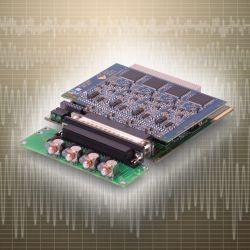
United Electronic Industries (UEI) is pleased to announce the release of the DNA-AI-211 analog input board. The board features 4 fully isolated, IEPE/ICP® accelerometer / vibration sensor channels and offers 24-bit resolution with a 109 dB signal to noise (S/N) ratio. Configured with an A/D per channel, the board offers sample rates up to 125 kS/s per channel (500 kS/s for the board). The AI-211 is specifically designed to allow direct connection to industry-standard 2-wire vibration sensors and provides both software and LED annunciation of open or shorted sensors.
The AI-211’s 100dB digital anti-aliasing filtering is provided by a combination of analog and digital FIR filters. The digital filter allows a combination of low passband ripple (±0.005 dB), steep falloff and low stop band floor (-100 dB) unattainable with simple analog filtering. The digital nature of the filter also ensures that each filter induces an identical phase shift, so no filter-induced inter-channel phase jitter will impact or corrupt subsequent analysis.
The DNx-AI-211 is fully supported by UEI’s comprehensive software suite, which includes factory written support for all popular operating systems (e.g., Windows, Linux, VxWorks), programming languages (e.g., C, C# and VB .NET) and application packages such as LabVIEW, MATLAB and DasyLAB. SyntaxError
“The DNA-AI-211 sets a new standard in the ICP/IEPE interface market” according to UEI President Shaun Miller. “In addition to the exceptional performance of the new board, no other vendor offers the flexibility of UEI’s Cube and RACKtangle form factors and Ethernet Slave, Data Logger, Programmable Automation Controller, or Simulink target deployment options.”
| PRICING & AVAILABILITY: | |
|---|---|
| For Cube based systems | Delivery from Stock |
| For RACKtangle systems | Two weeks |
About the “Cube”
UEI’s powerful “Cube” architecture is a compact (4 x 4 x 4″ or 4 x 4 x 5.8″) Ethernet based I/O platform. It may be deployed in five
configurations: 1) Ethernet I/O slaved to a host PC, 2) Stand alone Data Logger/Recorder, 3) Linux-based Programmable Automation Controller
(UEIPAC), or 4) Simulink Coder target (UEISIM), 5) Modbus TCP based I/O slave (UEI Modbus). Each Cube consists of a core module (with processor
and network interface) and three or six open I/O slots. Users select the deployment option and I/O boards that meet their system requirements. With over 30 I/O boards available, there’s sure to be a configuration to meet any application requirement. The six-slot Cube provides up to: 150 analog inputs (up to 24 ICP channels), 192 analog outputs, 288 digital I/O, 48 counter or quadrature channels, 72 ARINC-429 channels and/or 24 Serial or CAN-bus ports.
About the RACKtangle
The RACKtangle I/O chassis offers a similar capability as the cube, but in a more conventional, 3U rack form factor with easily replaced front-loading I/O boards. In addition, it offers 12 I/O slots and supports up to 300 A/D (including up to 48 ICP channels), 394 D/A, 576 DIO, 144 ARINC-429 or 96 CAN or Serial I/O ports. The Gigabit interface also provides two independent ports, one used for primary system control and the second used for real-time diagnostics.
About UEI
Founded in 1990, UEI is a leader in the PC/Ethernet data acquisition and control, Data Logger/Recorder and Programmable Automation Controller (PAC) markets. UEI’s I/O “Cube” and RACKtangle I/O chassis are compact, rugged platforms, ideal for DAQ, Logging and control applications in a wide assortment of applications and industries including automotive, aerospace/aviation, unmanned vehicles, appliance test, simulator control, in-vehicle test, wind and solar power system control, semiconductor manufacturing, medical equipment and more. UEI offers both COTS and customer products to OEMs, end-users and systems integrators worldwide. With analog, digital, counter, CAN-bus, Serial I/O, ARINC-429 I/O and more, UEI will have the interface you need. UEI supports all popular Windows, Vista, Linux and Real-time operating systems, programming languages and application packages including LabVIEW, MATLAB and DASYLab.
* * * *
